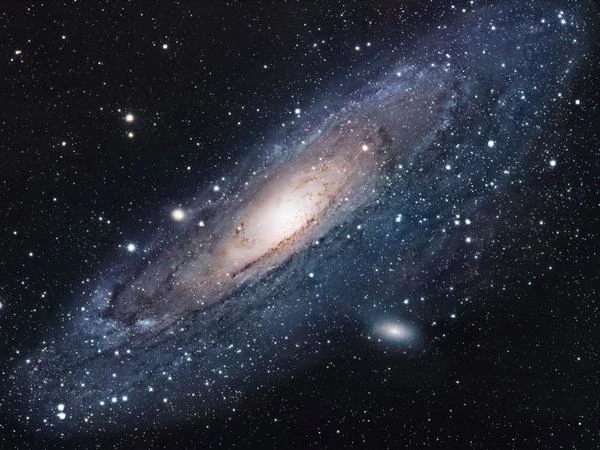
When astronomers pointed the Hubble Space Telescope at the center of the Andromeda galaxy (M31), located about 2.5 million light-years away, they made an unexpected discovery: its nucleus has not one, but two distinct peaks of brightness. This phenomenon, known as the "double nucleus," manifests as two stellar concentrations named P1 and P2, about 0.5 light-years apart. One (P2) coincides with the position of M31's supermassive black hole, while the other (P1) is brighter but off-center.
This doubling is unique among nearby large spiral galaxies and raises questions about the internal dynamics of the central bulge, the distribution of stars, and the role of the central black hole. How can such an apparently unstable structure persist?
Dynamic models suggest that this double nucleus could result from a disk of stars in an eccentric orbit around the central black hole. The stars in this disk follow elliptical trajectories slowly precessing around P2. This configuration creates an apparent overdensity at P1, without requiring the presence of a second black hole. This phenomenon is an example of a phase-shifted stellar distribution in gravitational resonance, stable over time under certain conditions.
The mass of M31's central black hole, estimated at about \(1.4 \times 10^8\ M_\odot\), influences the gravitational dynamics over several light-years. The gravitational lensing effect, differential rotation, and velocity dispersion are consistent with this interpretation, reinforced by N-body numerical simulations.
Another hypothesis suggests an ancient interaction or merger with a satellite galaxy. This scenario could have injected an off-center stellar subsystem or modified M31's central disk. Some observations of large-scale asymmetries, such as tidal loops visible around M31, support this idea. However, no direct evidence of a secondary stellar nucleus has been detected in the infrared domain.
The Milky Way and Andromeda (Messier 31) will collide in about 4 billion years. Understanding the internal structure of M31 is akin to anticipating the future of our own galaxy's core. If a double nucleus configuration can naturally emerge from a perturbed stellar disk, it could recur in the final bulge of the merged galaxy, sometimes called Milkomeda.
The mystery of Andromeda's double nucleus thus illustrates the extreme complexity of internal galactic dynamics, at the interface of celestial mechanics, stellar population dynamics, and gravitational relativity.
The Andromeda galaxy and our Milky Way gravitationally dominate the Local Group, a set of about 80 galaxies bound by gravity and extending over more than 10 million light-years. This group includes dwarf galaxies like M32, NGC 205, the Large and Small Magellanic Clouds, but its two main members are M31 and the Milky Way, together representing more than 90% of the group's total mass.
M31 is slightly more massive than the Milky Way, with a total mass estimated at about \(1.5 \times 10^{12}\ M_\odot\), compared to \(1.0 \times 10^{12}\ M_\odot\) for the Milky Way. Its apparent size in the sky, although diminished by its distance, extends over nearly 3°, or six times the angular diameter of the full Moon.
The dynamics of the Local Group show that M31 and the Milky Way are on a collision course, with a closing speed of about \(110\ \mathrm{km/s}\). This future merger will result in the formation of a new giant elliptical galaxy, expected in 4 billion years.